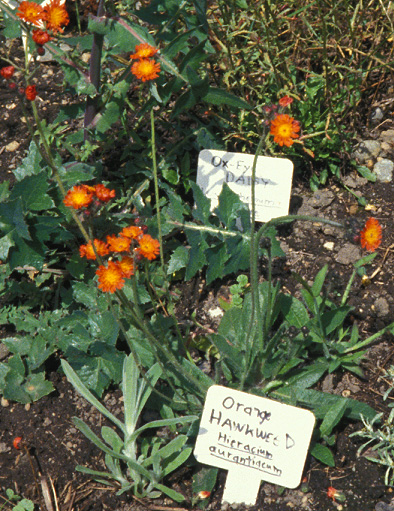
|

|
| Orange Hawkweed; Hieracium aurantiacum L. |
Sunflower Family; COMPOSITÆ (ASTERACEÆ)
|
| Orange Hawkweed is a dandelion cousin with no business being in this column except that it sports extraordinary
orange flowers. Although the Seattle area has a dozen or so yellow-flowered "dandelion lookalike" weeds, Orange Hawkweed alone has
carrot-colored flowers. In another respect, it also is unique: it hops around via runners quite like a strawberry plant. So, rare, yes: but
not forgettable. Some of its other names reveal more about it: Red Daisy, Red Weed, Devil's Bit, Devil's Paintbrush, Ladies'
Paintbrush, Flora's Paintbrush, Missionary Weed, Lion's Tongue, Tassel Flower, King Devil, and Grim the Collier (only in England). |
| Grim the Collier is a name to raise eyebrows. In a certain sense, it is no more imaginative than Frosty the Snowman.
The interesting thing is not that colliers
(i.e., coal miners) become grim and black, but that a little green plant came to be called by such
an odd name. Well, look real close at its flowerheads and you'll see tiny
blackish hairs, the cause of someone's fanciful thinking. |
| Curiously, the weed's leaves are softly coated with
white hairs. If these hairs were not so delicate they'd be fairly
termed bristles. Most hawkweeds (there are hundreds of species) are hairy, unlike dandelions. The hairs help conserve moisture, and
dissuade chewing animals. I eat Orange Hawkweed leaves, because the hairs are nothing so formidable, say, as those of borage or comfrey,
and the flavor, a gentle hint of bitter, serves to tease, not to torture. |
| The name "Hawkweed" is derived from the ancient Greek
hierax, a hawk, because the sap of one species was used
to strengthen eyesight. Do you think that far-fetched? Today, in our modern wisdom, people still use rhinoceros horn and other such
stuff for less useful ends (other anatomical endeavors), and at greater cost. |
| In any case, Orange Hawkweed, or Grim the Collier, is "one of the most pernicious weeds" of the northeastern U.S., but is
a minor player in the Pacific Northwest. I have seen it only six places in or near Seattle. However, unless seen in bloom during June
and July, it's inconspicuous. There are two or even three different variations of it, and one hybrid with fewer but darker and larger
flowers that is by far my favorite. |
| Several related genera of predominately yellow-flowered weedy plants bear confusingly similar common names.
Note carefully: the Hawkweed (Hieracium) of Seattle is exclusively the orange, except for our extremely rare woodland native
H. albiflorum, white flowered. Two species of Hawkbit
(Leontodon) are common, but get passed-over as runty dandelions by 99%
of observers. Hawk's-beard (Crepis
capillaris) is also common, and eventually will be featured in this column. |
If you're infested by Orange Hawkweed, try shading it to death, or salt it. Salt is said to kill it. If it's in a lawn, mowing
will only foil its flowering, but won't stop its runners. If you do not mow it, you shall see the flowerstems ascend to, depending upon
the exact clone, anywhere from 8 inches to over 2 feet.
|
Originally published as the Seattle Tilth newsletter Weed of the Month in June 1993, along with an illustration from a book.
Back |
|
|

